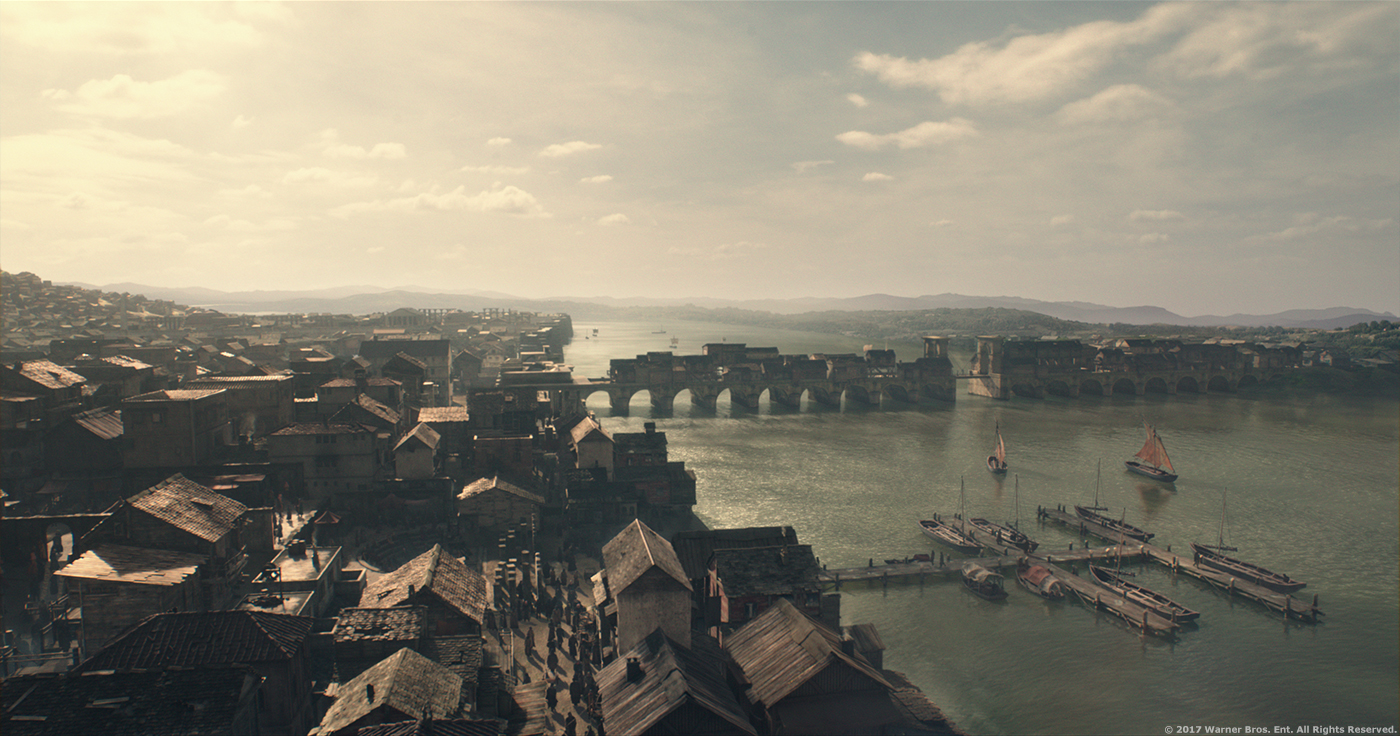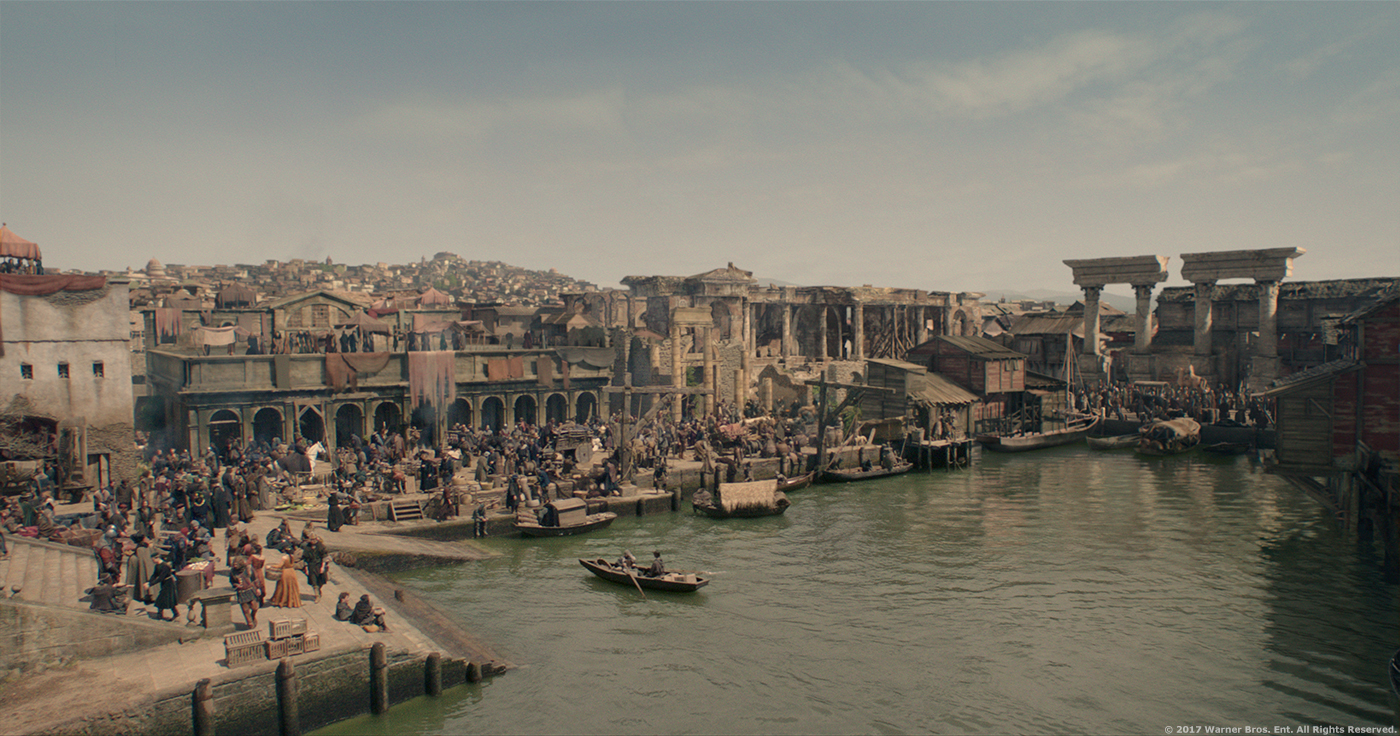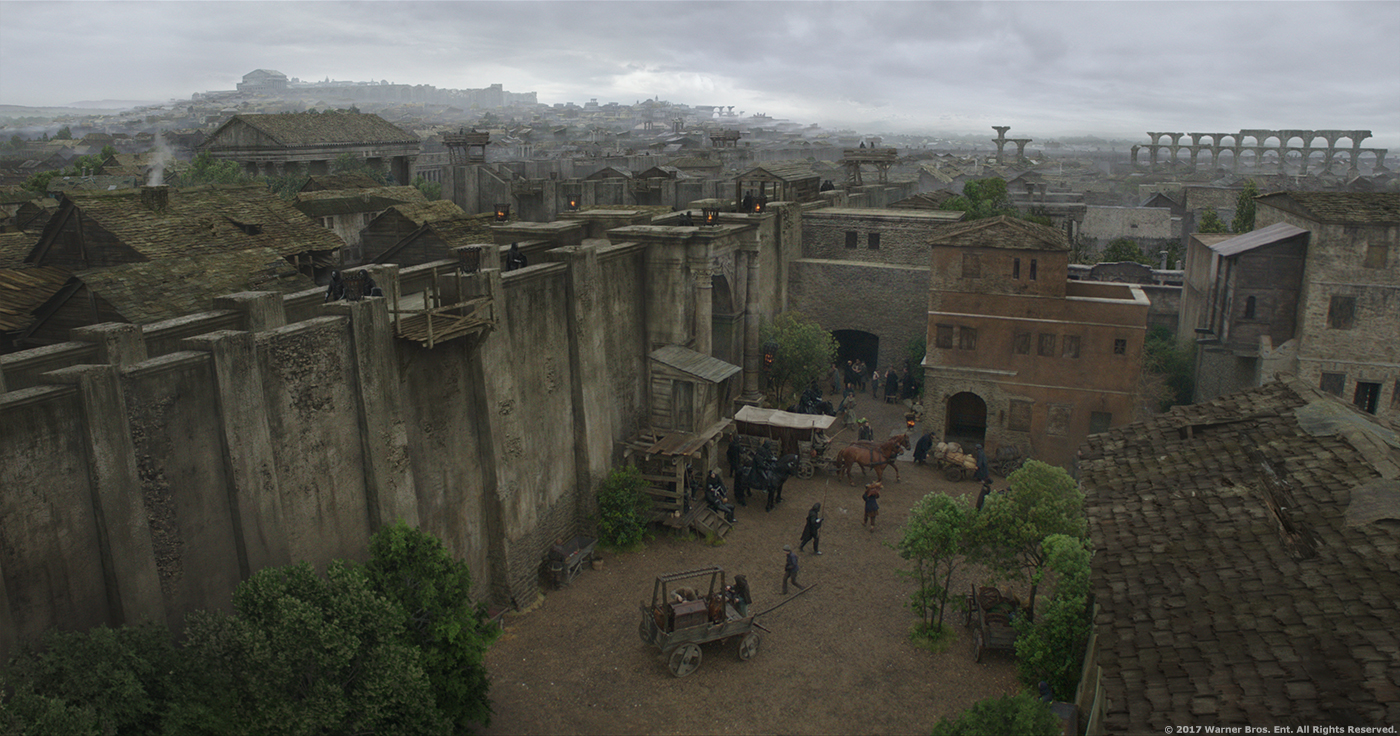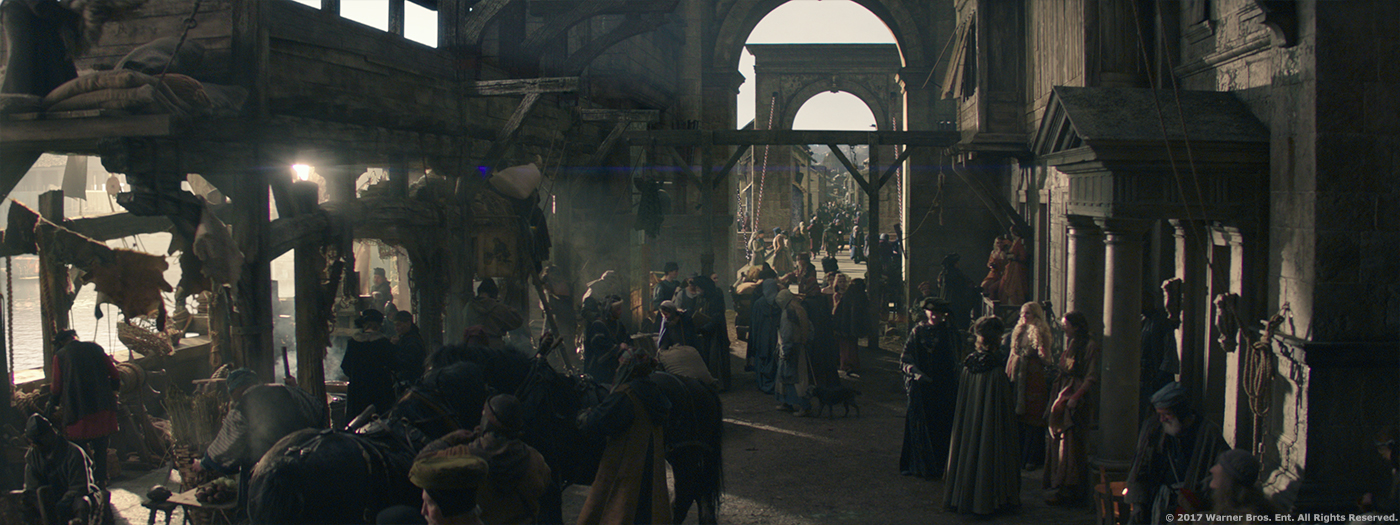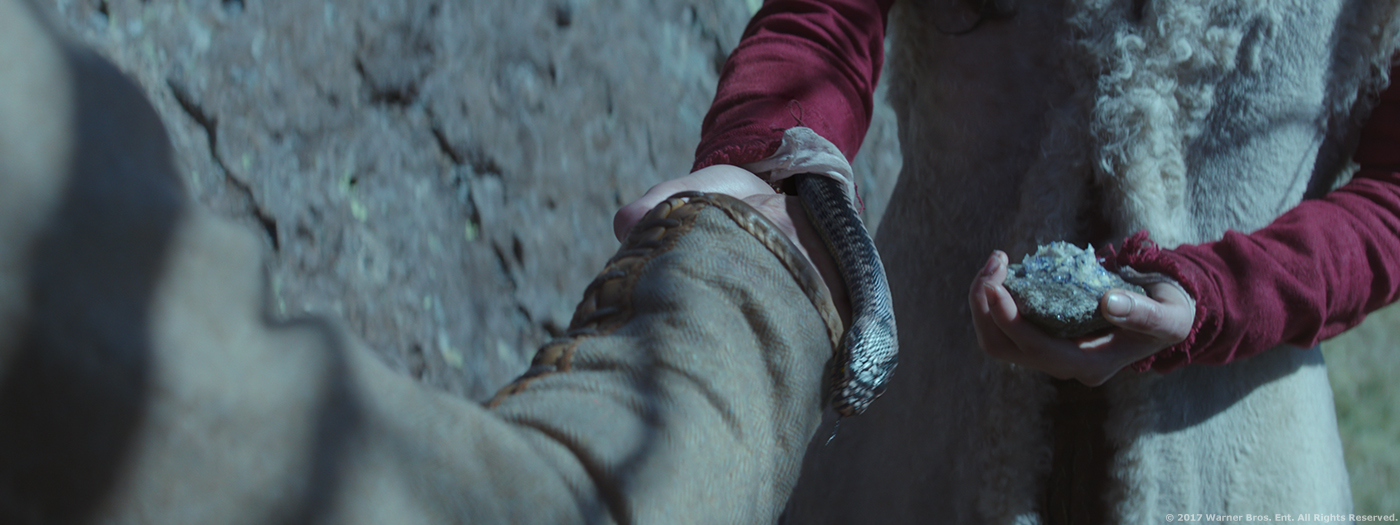In 2012, Olivier Dumont explained to us the work of Method Studios on WRATH OF THE TITANS. He then worked on many films such as GUARDIANS OF THE GALAXY, AVENGERS: AGE OF ULTRON, BATMAN V SUPERMAN: DAWN OF JUSTICE or VOYAGE OF TIME: LIFE’S JOURNEY.
How did you and Method Studios get involved on this show?
We were contacted by Nick Davis and Alex Bicknell for a potential role as one of the main vendors on the show. I also had already worked with Nick on WRATH OF THE TITANS and despite the craziness of it, we had a lot of fun. I guess the ongoing increasing recognition of Method Studios in the VFX industry and this previous relationship played a role.
How was the collaboration with director Guy Ritchie and VFX Supervisor Nick Davis?
My relationship was mostly with Nick and Alex as I had very little interaction with Guy Ritchie. I knew from my great past experience what to expect from working with Nick again and it wasn’t disappointing. Nick is great at leading the visual while also leaving a lot of room for creativity (which is to me the best part of the job). We are fortunate to have similar ways of visualizing things allowing us to go through all the challenges in much easier way. For instance, one of the challenges could have been the distance, Nick being in London, which means any communication time becomes very precious as we are working when London is not available and thinking alike becomes very useful. This collaboration was dialogue all along to figure out the way to make out the best visuals for the story.
What was their approaches and expectations about the visual effects?
The mood of this movie was that everything was supposed to be as grounded as possible despite the magic underlying so they wanted to stay away from too much of the more fantastic type of VFX. For instance, for our work on the creation of Londinium, I met with Gemma Jackson, the great production designer of GAME OF THRONES. She had done so much research about Londinium after the Romans built it (the sets were absolutely fantastic). We ended up buying a book based on her recommendation to help us understand the full scope of architecture. Londinium at that time had been abandoned by the Romans for more than 400 years. It had to show that a “less” civilized culture had taken over, hence the wood additions to the houses or the badly repaired structures you can see throughout the movie. Although we had to stay true to the architecture history, we still had to create a city that was probably 10 times bigger than the one that really existed.
Following the same line of thinking, the magic elements were always driven by natural elements: dust and stones in the bath house fight, the real snake coming out of the Mage’s sleeve to protect Arthur with its venom or the Mage’s eyes mimicking the animal eyes she is controlling. Nick and his second hat as a director himself helped us to make sure we didn’t lose the grounded part in the numerous full CG shots we had to create from scratch for the story.
What are the sequences made by Method Studios?
They were very diverse and I am probably missing some little ones. The main one was the build of Londinium for all the set extensions, the wide establishers and all that is happening inside throughout the movie. We also handled the travel of the boat with little Arthur on board, the travel back from the execution, set extension in their hideout, the sinking of Vortigen’s boats, Arthur’s dream of what the future would look like if does nothing, Mage’s Snake biting Arthur to protect him, the boat sequence of Arthur coming back from the Darklands, and Arthur fighting the blacklegs in Camelot before the fight with Vortigen.
How did you organize the work at Method Studios?
All the work has been done at our facility in Vancouver. Being based in LA, it was great that we had very good production team up there lead by a fantastic VFX producer, Jinnie Pak, who was keeping things in order through multiple work extensions when the release date was pushed. We also had a strong DFX supervisor to lead the team locally, Michael Cliett, who handled this complicated role perfectly.
As you can imagine the asset team had relentless work to build all necessary elements. Londinium required houses that should always look different and also all the little every day objects you would see in the street. After that you need to populate it with crowds and same thing here about the variety. The amount of work was gigantic. Layout was also an intricate task to place everything according to the shots as they were looking every direction.
The lookdev artists and lighters had to make sure we could be as photoreal as possible and could always count on the solid matte painting team to help getting there for the city shots. The animators and the cloth simulation artists had all kind of motion to play with from the background crowd to very foreground elements of Arthur and blacklegs fighting. The FX team had the heavy task of creating all the natural elements being used during normal and magic time like atmospherics, dust, smoke explosions or the water. A solid compositing team that was lead by Senior Compositing Supervisor Tom McHattie and Compositing Supervisor Allan Lee got us to the finish line.
The city is seen through various conditions and lighting. How did you handle this challenge?
The way I thought about it at the beginning was to build full districts of the city based on a very rough 3D model of the layout created by the art department. We used it to pinpoint locations of the events we had in the script. We would then build those districts and reuse them for continuity purposes. But that’s not the way Guy Ritchie works and beside the main events, most of the shots didn’t require any continuity so we forgot about that and went with the flow to make the shot look right at that moment for the movie. In other words, every of those shots became a one-off which was a bit more work as you had to start a new brief for each of them instead of using just one district already built and place the camera. We used a base of about 80 houses plus variations and hundreds of props to complete that challenge.
During a sequence, Arthur and his team is running away in the streets seen from the sky. Can you tell us more about these shots?
This was one of the many shots that came after we had started. Nick let us know ahead of time that the movie would need some establishers and that was one of them. The inspiration was coming from a shot where the camera jumped from one street to another and followed multiple characters. Michael concepted this shot working himself on the camera move with Nick’s directions. The shot was much longer originally and got cut shorter for pacing reasons. We didn’t have any elements shot for this so we had to create the digi-doubles for Arthur and his team; we already had the crowd and the blacklegs. Everything was a question of timing and logic. The blacklegs had to react accordingly to the team running and the explosions happening above them. They also had to have some purpose before being alerted like checking citizens or guarding certain areas to feel that they were part of the trap. All of this was thought out and animated accordingly. We used a lot of motion capture elements but a lot has been touched up to matched the exact action needed.
How did you populate the streets of the city?
We used Massive to drive our crowd through the street and their thousands of actions. We went through a lot of iteration to make sure nothing was looking too staged or too perfect.
Many destructions happens in Londinium. Can you tell us more about it?
Indeed, we burned the Palace and one administration office, we blew up the bathhouse, we burned the brothel and we had to spread riots all over Londinium. Everything needed a different kind of destruction vector. We used Houdini to creating huge plumes of smoke for the Palace, while the brothel required more localized fire and we used everything in between for the riots. The crowd had to be reacting to this as well so more motion capture and animation were involved.
At a moment, Arthur has a snake on it. How did you created it?
We got a specific species to replicate (an adder) so we got as many references as we could (image of adders and video of snakes climbing). We then worked on the model, rigging and lookdev. The challenge, once we figured out a way for the snake to climb up Arthur’s sleeve in what we hope was a believable manner, was to get the clothing moving accordingly when it exits the sleeve and climbs.
How did you handle his rigging and animation?
We knew that we would need a solid rigging and deformation for the body so we studied the videos and made sure we had also a solid base for the roto-animation of Arthur’s arm to prevent any sliding look. The animation was another study of snakes climbing on trees, walls and so on, and it was fascinating to see that kind of agility. Basically the snake finds anchor points and those are the only marks where the snake doesn’t slide. The snake could undulate in between but never at those points; this was what made it work.
In a flashback, Arthur can see a dark future. How did you created this devastated environment?
These were brought to us at the very end. Nick came with concepts that we interpreted with the elements we had already built to deliver on time. We still had to destroy most of those elements and this specific task was shared between CG and matte painting. The elephant in the BG was rendered by MPC based on our lighting and was then comped by us.
How did you find the specific look of the flashback?
We had to find a dreamy look to apply to it and went through some grading of the plates to bring all the elements together. The dreamy look was obtained through layering of effects made in Nuke to keep some depth to it.
When Arthur is using Excalibur is has super speed and strength. Can you explain in detail about the creation of the beautiful action sequence in the castle?
The logic of the sword was, when Arthur grabs it with his two hands, everything slows down around him. One of the first shot we experimented with was the one on top of the stairs right after he grabs the sword with his hands. We explored how slow this would be through the animation of the blacklegs. We didn’t use any motion control as we needed to stay true to the Guy Ritchie style and went full on with the blackleg digi-doubles. We also wanted to see a remnant of what Arthur went through during the bathhouse by adding the dust cloud that forms around him to link the events. But now, he is more in control and it didn’t have to be so chaotic. We thought it would bind the action and the magic more without being over the top.
For some shots, we were able to use multi plates to get the slow motion effects but most of the time, and especially the long shot of Arthur fighting the the blacklegs, we used full CG characters. The latter was a full CG shot and we borrowed the castle from Framestore to make our own for this fight.
How did you created the various digi-doubles for this sequence?
The blacklegs were the first high-res characters we created for the movie and were shared with the other vendors as needed. We had plenty of time to create the best version of that. Arthur became a little more tricky as the sequence wasn’t supposed to be like that from the get go. Built as an afterthought, it was hard to get all the information needed from the actor since we had very limited access to him once the main photography was done, and we weren’t able to get the usual FACS poses up front to build expressions and the rig. We chose then to work with face replacements where the CG was breaking. Some of the face replacements were even coming from other shots. We got a very good help from the production VFX editor to find those.
Many FX are also involve during this fight. Can you tell us more about it?
FX in this sequence included the smoky element coming off Arthur’s sword and the dust and pebbles we see rising when he grabs it with his two hands, the dust that follows Arthur and his moves, the fire pit Arthur throws at the blacklegs, the sweat coming off the punch and the dust from the hits, the breaking of the spear, and the dust following the arrows and the big shockwave taking out the archers. We also added the multiple fire pits and torches all over the courtyard. One thing to know is that FX and re-speed do not work well together and every moment becomes a challenge. We found out that the best way to get the FX working is to animate everything real time and slow it down and then use subframes to generate the proper look but that comes with a lot of inconveniences as every one of those subframes needs to be worked on as well. It was at the end a mix of several techniques that got us through.
What was the main challenge on this show and how did you achieve it?
If the long full CG shot of Arthur’s fight in the castle was probably the most challenging, the build of Londinium was a marathon.
Was there a shot or a sequence that prevented you from sleep?
Not really, thanks to the great team I had in Vancouver. But I surely had some lack of it…
What is your best memory on this show?
Surely the collaboration with Nick Davis and Alex Bicknell, his VFX producer, and their sense of humor made it easier get through the usual challenges. Our Method team was great, and also a real pleasure to work with.
How long have you worked on this show?
Almost 2 years.
What is your VFX shots count?
Around 430 shots, but we worked on more than 600.
What was the size of your team?
In the hundreds.
A big thanks for your time.
// WANT TO KNOW MORE?
Method Studios: Dedicated page about KING ARTHUR: LEGEND OF THE SWORD on Method Studios website.
© Vincent Frei – The Art of VFX – 2017

